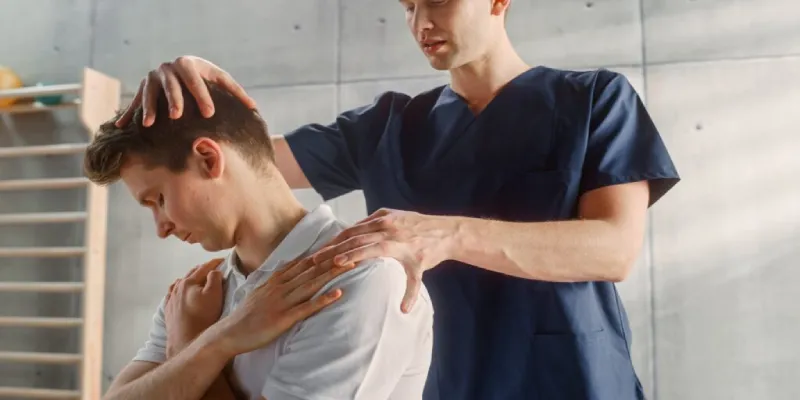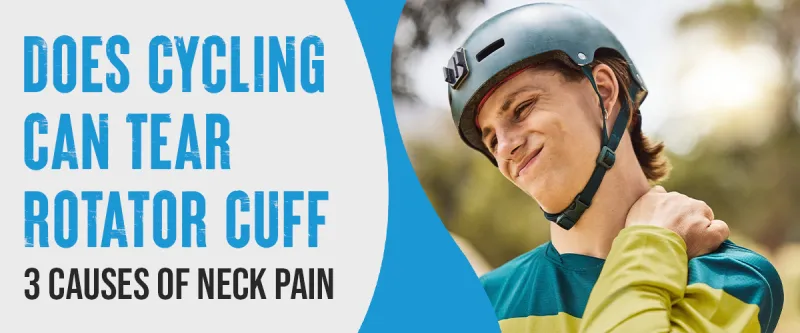A rotator cuff is a group of muscles that hold the arm in its socket. If damaged or torn completely, the arm becomes extremely painful and difficult to move. Torn rotator cuffs can also cause pain in the shoulder and neck.
Yes, cycling can potentially lead to rotator cuff tears. Endurance rides lasting over an hour can place significant stress on the shoulders, especially the rotator cuff, a key stabilizing muscle. It is important to ensure proper shoulder strengthening exercises and techniques to prevent injury while cycling.
In this post, we’ll discuss the causes of rotator cuff injury and neck pain from cycling, along with a few suggestions for preventing them.
Does Cycling Tear The Rotator Cuff? 3 Surprising Risks

Cycling is undoubtedly a fantastic cardiovascular exercise, offering many health benefits. Like any physical activity, it’s not without its pitfalls. We’ll delve into how cycling can become a potential culprit in causing neck and rotator cuff injuries.
Repetitive Stress: The Silent Aggressor
Repetitive stress is a silent but formidable foe for cyclists. While the rhythmic motion of pedaling may feel therapeutic, the shoulder joints are subjected to a constant barrage of stress. Over time, this unrelenting pressure can contribute to rotator cuff injuries and weak muscles.
Cycling Mechanics
- Analyzing the biomechanics of cycling and its impact on shoulder joints.
- Highlighting the areas vulnerable to repetitive stress.
Signs and Signals
- Recognizing early warning signs of rotator cuff strain.
- The importance of listening to your body and acknowledging discomfort.
Overuse of Shoulder Muscles
Passion for cycling can sometimes lead to overenthusiastic pedaling, unwittingly subjecting the shoulder muscles to excessive strain. Let’s explore how the hunger for the ride may inadvertently contribute to overuse and rotator cuff injuries.
The Passion Paradox
- Acknowledging the love for cycling without compromising shoulder well-being.
- Establishing healthy cycling routines to prevent overuse.
Strengthening Strategies
- Incorporating shoulder-strengthening exercises into your fitness regimen.
- Consulting with fitness experts for tailored workout plans.
Incorrect Bike Fit or Posture
One often underestimated factor in cycling-related injuries is the importance of proper bike fit and posture. Discover how a seemingly trivial misalignment can manifest into significant issues for your rotator cuff and neck.
The Fit Dilemma
- Understanding the role of bike fit in preventing shoulder strain.
- Tips for ensuring your bike is tailored to your body’s unique needs.
Posture Perfect
- Unveiling the significance of maintaining proper posture while cycling.
- Practical tips for adjusting your posture during rides.
Cycling & Rotator Cuff Injury: 3 Prevention Techniques
Cycling is a fantastic exercise that benefits cardiovascular health, but it’s crucial to be mindful of potential issues like neck pain and rotator cuff injuries. We will explore practical ways to prevent and treat rotator cuff injuries related to cycling.
Proper Warm-Up Before Cycling

A proper warm-up before cycling is an essential step to preventing injuries. Warming up helps raise your body temperature, increasing blood flow and loosening up your muscles.
This can help prevent tearing or straining of the rotator cuff muscles and tendons and alleviate neck pain. Some simple and effective warm-up exercises you can do before cycling include:
- Slowly pedal on a stationary bike for 10-15 minutes.
- Arm circles and shoulder rolls.
- Neck rotations and stretches.
- Upper back stretches.
Stretching and Strengthening Exercises
Stretching and strengthening exercises play a critical role in injury prevention. These exercises can help improve flexibility and the mobility of your neck and shoulder muscles, making them better able to handle the stress of cycling. Some great exercises to strengthen and stretch your shoulders and neck include:
- Shoulder external rotation exercises, such as the side-lying external rotation exercise, strengthen your rotator cuff muscles.
- The shoulder blade squeezes to strengthen the muscles that stabilize your shoulders.
- Yoga poses like the Downward-facing Dog and Cow Face Pose can help stretch and strengthen your upper body muscles.
- Neck stretches such as lateral flexion, rotations, and chin tucks to increase neck mobility.
Correct Bike Fit and Posture
Another critical factor in preventing neck and rotator cuff pain is ensuring that your bike fits you correctly and that your posture is correct while cycling. A poor bike fit or incorrect posture strains muscles, causing pain and injury. Here are some things you should do to optimize your bike fit and posture when cycling:
- Properly adjust your saddle height and handlebar position. This will help ensure that your body is in the correct position while cycling, reducing strain on your neck and shoulders.
- Keep your elbows bent and close to your body when you cycle. This helps reduce the strain on your shoulder muscles.
- Keep your head and neck neutral, looking straight ahead rather than upwards or downwards. This will help reduce the tension in your neck muscles.
Medical Treatment Options

If you sustain a rotator cuff injury or neck pain while cycling, several medical treatment options are available to you, depending on the severity of your injury.
Therapy can increase joint mobility, alleviate pain, and strengthen muscles to prevent further injury. Your physical therapist may use manual therapy, stretching exercises, and strengthening exercises to help you recover and prevent future injuries.
Managing pain and inflammation caused by rotator cuff injuries and neck pain is possible. NSAIDs or acetaminophen can relieve pain and swelling.
Most cases of rotator cuff injuries do not improve with other treatments. Surgical repair can help restore shoulder mobility and reduce pain but may require a long rehabilitation period
Conclusion
Cycling and enjoying the outdoors can help you stay fit, but it’s important to remember that they can also stress your body. Taking the proper precautions before and during your ride is crucial to preventing rotator cuff tears and neck pain.
You can provide a long and successful cycling journey by warming up properly, stretching and strengthening your muscles, and ensuring proper bike fit and posture. You should seek medical attention if you experience pain or discomfort to get back on track and keep cycling.
FAQs
Why Do Cyclists Get Neck Syndrome?
A fatigued deep neck extensor can result from the extended neck position if it is not enough to support the head weight over a long period. Trapezius muscles and other neck muscles can become stiff and painful over time.
Can I Cycle with A Rotator Cuff Injury?
Cycling with a rotator cuff injury is not advisable as it can cause pain and worsen the damage, especially if surgery hasn’t been done. Recovery time varies based on injury severity and cycling type. It’s best to wait until the shoulder is fully healed and get a doctor’s advice before cycling again.
Can A Torn Rotator Cuff Cause Neck Pain And Headaches?
Yes, a torn rotator cuff can cause neck pain and headaches. When the rotator cuff is damaged or torn, the ache can radiate from the shoulder to the neck, causing discomfort. This can lead to neck pain and even headaches in some cases.
Can Rotator Cuff Tendonitis Cause Neck Pain?
Yes, rotator cuff tendonitis can cause neck pain in some cases. Patients with a rotator cuff tear may experience neck pain that radiates from the top of the shoulder to the base of the neck. This neck pain can be a common complaint during evaluations in the clinic.
Can You Get Rotator Cuff Pain in The Neck and Head From Cycling?
Yes, rotator cuff pain can radiate from the top of the shoulder up to the base of the neck. It is common for patients with a rotator cuff tear to experience neck pain connected to shoulder discomfort. Individuals with rotator cuff issues frequently report this radiating pain.


